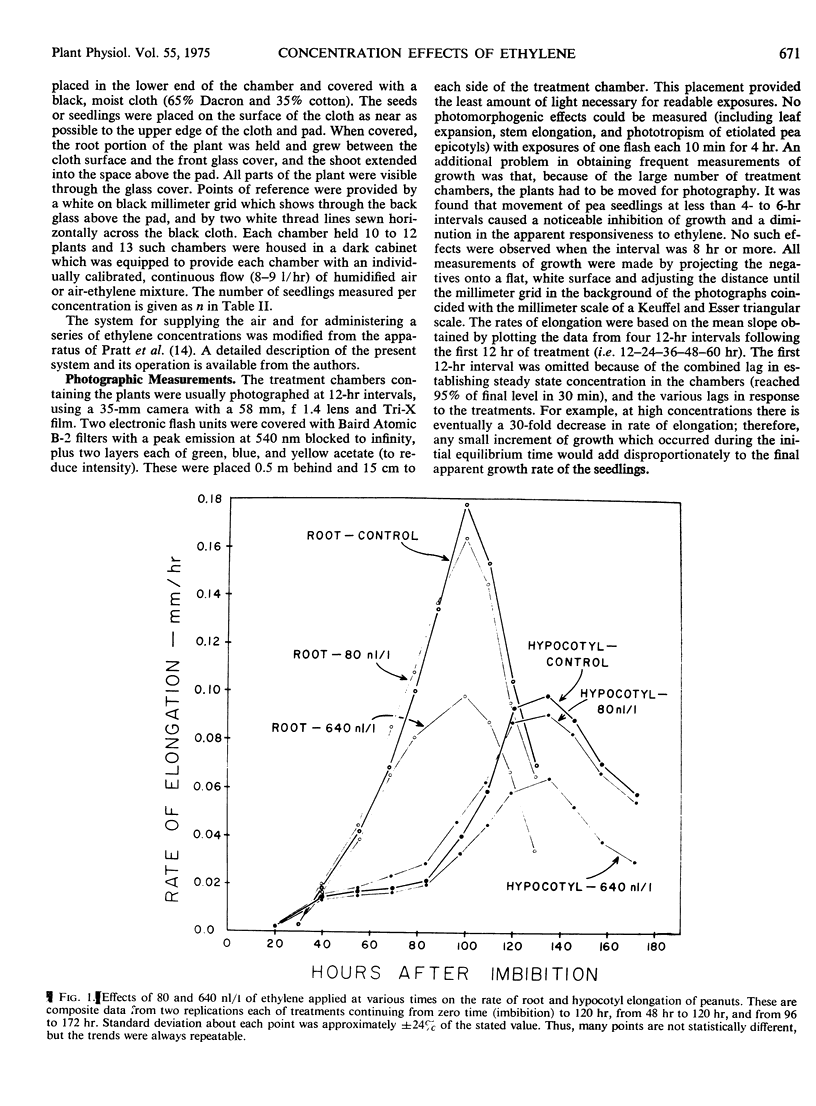Abstract
The effects of a series of concentrations of ethylene (10, 20, 40, to 10,240 nl/l) on elongation, diameter, and geotropism of the stems and roots of etiolated seedlings of Pisum sativum L., Arachis hypogea L., Phaseolus vulgaris L., and Gossypium hirsutum L. were measured or observed. Of the 24 possible responses, 4 were unaffected at the concentrations used, 5 were affected slightly, and the remaining responses exhibited a 14-fold range of apparent half-maximum concentration dependencies (i.e. 95 nl/l for the effect on pea epicotyl geotropism to 1350 nl/l for the promotion of cotton hypocotyl diameter). Six or possibly eight of these responses appear to have the same concentration dependencies while the others fell in pairs or as individual responses. The data, if interpreted in a manner analogous to enzyme kinetics, are indicative of more than one primary mechanism for ethylene action in plants.
Full text
PDF







Selected References
These references are in PubMed. This may not be the complete list of references from this article.
- Apelbaum A., Burg S. P. Effect of Ethylene on Cell Division and Deoxyribonucleic Acid Synthesis in Pisum sativum. Plant Physiol. 1972 Jul;50(1):117–124. doi: 10.1104/pp.50.1.117. [DOI] [PMC free article] [PubMed] [Google Scholar]
- BURG S. P., BURG E. A. ETHYLENE ACTION AND THE RIPENING OF FRUITS. Science. 1965 May 28;148(3674):1190–1196. doi: 10.1126/science.148.3674.1190. [DOI] [PubMed] [Google Scholar]
- Burg S. P., Burg E. A. Molecular requirements for the biological activity of ethylene. Plant Physiol. 1967 Jan;42(1):144–152. doi: 10.1104/pp.42.1.144. [DOI] [PMC free article] [PubMed] [Google Scholar]
- Burg S. P. Ethylene in plant growth. Proc Natl Acad Sci U S A. 1973 Feb;70(2):591–597. doi: 10.1073/pnas.70.2.591. [DOI] [PMC free article] [PubMed] [Google Scholar]
- Eisinger W. R., Burg S. P. Ethylene-induced Pea Internode Swelling: Its Relation to Ribonucleic Acid Metabolism, Wall Protein Synthesis, and Cell Wall Structure. Plant Physiol. 1972 Oct;50(4):510–517. doi: 10.1104/pp.50.4.510. [DOI] [PMC free article] [PubMed] [Google Scholar]
- Goeschl J. D., Pratt H. K., Bonner B. A. An effect of light on the production of ethylene and the growth of the plumular portion of etiolated pea seedlings. Plant Physiol. 1967 Aug;42(8):1077–1080. doi: 10.1104/pp.42.8.1077. [DOI] [PMC free article] [PubMed] [Google Scholar]
- Pratt H. K., Workman M., Martin F. W., Lyons J. M. Simple Method for Continuous Treatment of Plant Material with Metered Traces of Ethylene or Other Gases. Plant Physiol. 1960 Sep;35(5):609–611. doi: 10.1104/pp.35.5.609. [DOI] [PMC free article] [PubMed] [Google Scholar]
- Stewart R. N., Lieberman M., Kunishi A. T. Effects of ethylene and gibberellic Acid on cellular growth and development in apical and subapical regions of etiolated pea seedling. Plant Physiol. 1974 Jul;54(1):1–5. doi: 10.1104/pp.54.1.1. [DOI] [PMC free article] [PubMed] [Google Scholar]


